Choosing the right chew toys for your puppy is key for their health and happiness. Puppies love to chew, and the right toys can stop them from chewing on things they shouldn’t. This keeps your home safe and your puppy happy.
In this guide, we’ll look at the top chew toys for puppies. We’ll focus on toys that are safe, last long, and help your puppy grow. Whether you’re new to pet parenting or want to add to your puppy’s toys, this article will guide you. It ensures your puppy’s playtime is fun and safe.
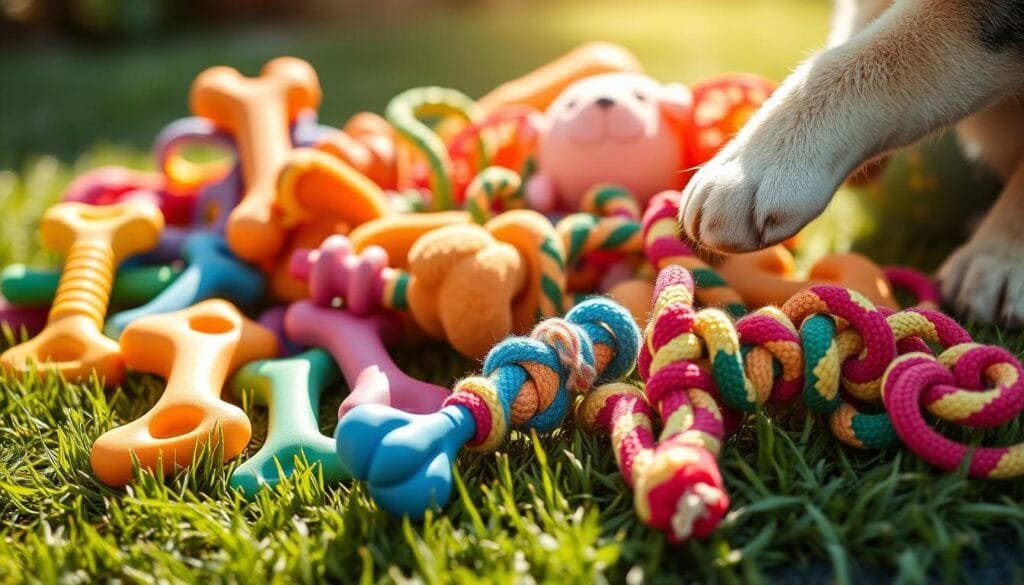
Key Takeaways
- Choosing the right chew toys is crucial for your puppy’s dental health and well-being.
- Safe and durable chew toys can help prevent destructive behaviors and protect your home.
- This guide will explore the best recommended chew toys for puppies, focusing on safety and developmental benefits.
- Learn how to select age-appropriate and size-appropriate chew toys for your growing puppy.
- Discover the best materials and safety standards to consider when choosing puppy chew toys.
Understanding Why Puppies Need Chew Toys
When your puppy teething, it’s key to give them the right dog chewing toy options. This is for their dental health and happiness. Puppies chew naturally for many reasons.
Teething Process and Dental Health
Puppy teeth start coming in at 3-4 weeks. They keep losing baby teeth and growing adult ones until they’re 6-7 months old. Their gums are sore during this time. Chewing helps ease this pain.
Offering puppy chew toys helps protect their teeth and gums. This stops them from chewing on things they shouldn’t.
Natural Chewing Instincts
- Chewing is a normal and necessary behavior for puppies. It helps them explore and fight boredom.
- Providing chew toys for puppies gives them a healthy way to chew. It stops them from chewing on furniture, shoes, or other things.
Benefits of Proper Chewing Habits
Teaching your puppy to chew on the right toys is good for them. It keeps your stuff safe and helps their health. Good chewing habits can:
- Make their jaw muscles strong and keep their teeth and gums healthy
- Help them feel less stressed and anxious by giving them something to chew on
- Stop them from getting bored and acting out, like barking too much or scratching
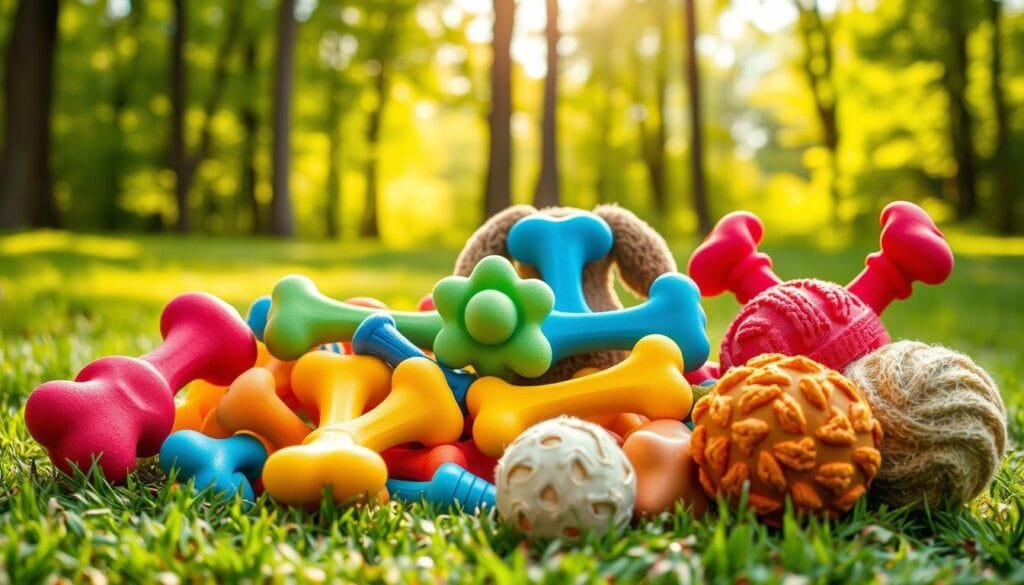
“Chew toys are essential for puppies to maintain dental health and satisfy their natural chewing needs.”
Knowing how important dog chewing toy options are for your puppy helps them grow well. It’s a key part of their development.
Safety First: Materials and Durability Standards
Choosing the right indestructible large dog toys and chewable dog toys is key. You need to pick toys that are safe and last long. Make sure they are made from non-toxic materials and are very durable.
Search for toys made from top-notch materials like natural rubber, silicone, or strong nylon. Stay away from cheap plastics that can break and cause harm. Also, avoid toys with small parts that can be swallowed.
- Look for toys with the ASTM International or CPSC safety seal. This means they’ve passed strict safety tests.
- Make sure the toy doesn’t have sharp edges or points. These can hurt your puppy’s gums and teeth.
- Pick toys that fit your puppy’s size and breed. They should be big enough not to be swallowed or broken into pieces.
It’s important for toys to be tough. Your puppy’s strong jaws can damage weak toys fast. Find toys that can handle a lot of chewing without breaking.
“Investing in high-quality, durable indestructible large dog toys and chewable dog toys is an investment in your puppy’s safety and well-being.”
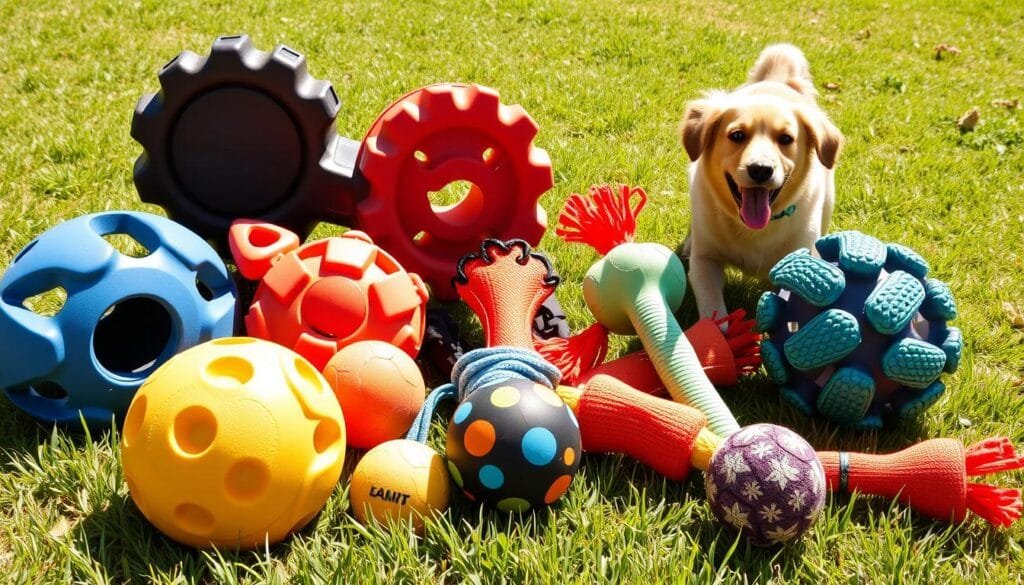
By focusing on safety and picking the right toys, you make playtime safe and fun for your puppy. This way, your puppy can enjoy without worrying about dangers.
Recommended Chew Toys for Puppies: Top Picks for 2024
Chew toys are key to keeping your puppy happy and healthy. In 2024, there are many great options for your pup. Let’s look at some top picks for puppies, sorted by material.
Rubber and Natural Rubber Options
Rubber and natural rubber chew toys are favorites for their durability and safety. They come in fun textures and shapes that encourage chewing. Check out the Nylabone Puppy Chew and the Kong Puppy Teething Stick for their toughness.
Rope and Cotton Toys
Soft chew toys like ropes and cotton are great for puppies. They’re gentle and let your puppy chew without hurting their mouth. The Frisco Puppy Rope Toy and the Benebone Dental Chew are good for teething.
Dental-Specific Chew Toys
There are chew toys made just for your puppy’s dental health. The Virbac C.E.T. Enzymatic Oral Hygiene Chews and the Greenies Puppy Dental Treats clean teeth and satisfy chewing.
When picking chew toys, think about your puppy’s size, age, and likes. Watch them play and change toys often for a safe, fun time. Remember, the right chew toys for puppies are important for their growth and health.
Size and Age-Appropriate Toy Selection
Choosing the right chew toys for puppies is key. Puppies need different toys as they grow. The right toy helps their teeth and keeps them happy.
Puppies of all breeds and ages need special chew toys. Their jaws and teeth grow at different rates. This means they need toys that fit their needs.
Choosing the Right Size
Finding the right size for puppy chew toys is very important. It keeps them safe and lets them enjoy the toy. Here are some tips:
- The toy should fit their mouth size. It should be big enough not to be swallowed, but small enough to chew.
- Small breeds need toys 3-4 inches in diameter. Big breeds can handle toys up to 6 inches.
- Always watch your puppy with chew toys. This stops them from swallowing pieces.
Adapting to Age and Teething Stages
As puppies grow, so do their needs. Choose toys that match their age:
- Teething Puppies (3-6 months): They need soft toys like rubber or silicone to ease sore gums.
- Growing Puppies (6-12 months): They can handle tougher toys like rope or nylon.
- Adult Dogs (12+ months): They need strong, long-lasting chews like antlers or bully sticks.
By picking the right chew toys for puppies, you keep them happy and healthy. This is especially important during their growing years.
| Puppy Age | Recommended Chew Toy Types | Toy Size Guidelines |
|---|---|---|
| 3-6 months (Teething) | Soft, pliable rubber or silicone chews | 3-4 inches in diameter |
| 6-12 months (Growing) | Rope, nylon, or moderate-hardness chews | 4-5 inches in diameter |
| 12+ months (Adult) | Tough, long-lasting chews like antlers or bully sticks | 5-6 inches in diameter |
“Investing in the right chew toys for puppies can make all the difference in supporting their dental health and satisfying their natural chewing instincts.”
Best Materials for Puppy Chew Toys
Choosing the right chew toys for your puppy is key. Materials like natural and synthetic ones have their own benefits. We’ll look at the good and bad of each, and eco-friendly choices that are safe and fun for your pet.
Natural vs. Synthetic Materials
Natural materials, like rubber, wood, or plant-based fibers, are good for the planet. They’re also gentle on your puppy’s teeth and gums. This helps them chew healthily.
On the other hand, synthetic materials, such as nylon or plastic, are very durable. But, they must be non-toxic and safe for your puppy to chew.
Durability Rankings
- Rubber and natural rubber: Very durable and long-lasting, with a soft texture that’s gentle on teeth.
- Nylon and plastic: Very durable, but need close watch to avoid choking hazards.
- Rope and cotton: Moderately durable, with a natural fiber texture that can help clean teeth.
- Rawhide: While popular, rawhide can pose a risk of splintering and should be used with caution.
Eco-Friendly Options
For those who care about the environment, there are many chewable dog toys and
- Biodegradable plant-based polymers
- Recycled rubber or plastic
- Organic, all-natural materials like hemp or bamboo
These options meet your puppy’s chewing needs and your environmental values. They’re a smart choice for pet owners who care about the planet.
Signs of Wear and When to Replace Chew Toys
Watching your puppy’s chew toys is key. Dog chewing toys and chew toys for puppies can get worn out. This can be dangerous if not checked often. Regular checks keep playtime safe and fun for your pet.
Here are signs it’s time for a new chew toy:
- Visible cracks, tears, or chunks missing from the surface
- Softening or becoming crumbly, which can be a choking hazard
- Sharp edges or points that could cut or scratch your puppy’s gums and mouth
- Unraveling or loose pieces that could be swallowed
Most dog chewing toys and chew toys for puppies need a change every 2-3 months. But, some toys might need a new one sooner if they show wear.
“Maintaining the condition of your puppy’s chew toys is crucial for their safety and well-being. Replace any worn or damaged toys to prevent potential hazards.”
Being quick to replace chew toys for puppies keeps playtime safe and fun. Always put your puppy’s health and safety first.
Avoiding Harmful Toys and Materials
Choosing the right recommended chew toys for puppies is key. Puppies love to chew and can get into trouble. It’s important to pick toys that are safe for them.
When looking at puppy chew options, watch out for dangers. Knowing what to avoid can help keep your puppy safe.
Common Dangerous Components
- Toxic materials: Stay away from toys with lead, zinc, or heavy metals. These can harm your puppy if they eat them.
- Sharp edges or points: Choose toys with smooth surfaces. This helps prevent mouth injuries.
- Small parts: Avoid toys with small pieces that can be swallowed. They can choke your puppy.
- Soft or brittle plastics: These can break and get stuck in your puppy’s stomach.
Red Flags to Watch For
- Poorly constructed toys: Look for toys made with strong materials. They should last a long time.
- Lack of manufacturer information: Good brands tell you about their toys. They share safety info and how to use them.
- Unfamiliar or unverified brands: Stick with brands you know and trust. They are safer for your puppy.
- Secondhand or used toys: New toys are safer. They don’t have hidden dangers.
Being careful and informed helps your puppy have fun and safe playtime. Always choose the best recommended chew toys for them.
How to Introduce New Chew Toys to Your Puppy
Introducing new chewable dog toys to your puppy is exciting but needs care. Follow these tips for a smooth transition and positive feelings:
- Start Slow: Show the new dog chewing toy for short times. Let your puppy get used to it slowly. This makes them feel safe.
- Use Positive Reinforcement: When your puppy shows interest, praise and reward them. This makes them want to explore more.
- Make it Irresistible: Rub the toy with a tasty treat or sprinkle it with safe seasoning. This will make your puppy curious.
- Rotate Toys: Change your puppy’s chewable dog toys often. This keeps them excited and prevents boredom.
By following these steps, you can introduce new dog chewing toys well. This helps your puppy have good chewing habits and keeps their teeth healthy.
“Introducing new toys to your puppy with care and patience can lead to a lifetime of happy, healthy chewing habits.”
Remember, the secret to introducing chewable dog toys is to go slow and use positive feedback. Think about your puppy’s interests and needs. With the right steps, your puppy will love their new toys.
Supervising Puppy Playtime with Chew Toys
Keeping an eye on your puppy during playtime with chew toys for puppies is key. It helps avoid accidents and teaches good chewing habits. As they learn through their mouth, safe play and watching for bad chewing signs are vital.
Creating Safe Play Sessions
Always watch when you give your puppy puppy chew toys. Stop them if they bite too hard or chew too much. Teach them to chew gently by giving them the right toys and praising them when they do.
- Give them many chew toys for puppies to keep them interested.
- Change the toys often to keep them fun and prevent boredom.
- Make sure the toys fit their age and size.
Warning Signs of Aggressive Chewing
It’s important to know when your puppy is chewing too hard. This could mean they need a different toy or help.
- They chew on things they shouldn’t, like furniture.
- They growl or snarl when playing with chew toys for puppies.
- They won’t give up a toy or get too attached to it.
If you see these signs, talk to a trainer or vet. They can help keep your puppy safe and happy.
Watching your puppy and knowing when to step in helps them have fun and safe play. This way, they can enjoy exploring with healthy puppy chew habits.
Cleaning and Maintaining Puppy Chew Toys
It’s key to keep your puppy’s chew toys clean and in good shape. This ensures they stay safe and last longer. Cleaning them regularly gets rid of dirt, saliva, and bacteria.
How you clean your puppy’s chew toys depends on their material. Rubber and natural rubber toys can be washed with warm, soapy water and a soft brush. Rope and cotton toys might need a machine wash on a gentle cycle. Always check the maker’s instructions for the right cleaning method.
After cleaning, store your puppy’s chew toys in a cool, dry spot. Keep them away from sunlight or heat, which can damage the materials. Check the toys often for wear or damage. Replace them when needed to keep your puppy safe and happy.
FAQ
The best chew toys for puppies are safe and durable. They should satisfy their chewing needs and help with dental health. Rubber, rope, and dental chew toys are great options.
Puppies need chew toys for several reasons. Chewing helps soothe their gums during teething. It also helps develop their jaw muscles and keeps their teeth clean. The right chew toys prevent destructive chewing and teach good habits.
Choose non-toxic, durable materials for your puppy’s chew toys. Avoid small parts that could choke them. Look for toys that can handle heavy chewing without breaking.
Pick chew toys that fit your puppy’s age, breed, and chewing habits. Start with small, soft toys for their small mouths. As they grow, switch to larger, more durable ones. Make sure the toy matches their size and chewing strength.
Choose natural and synthetic materials that are safe and durable. Natural rubber, cotton, and rope are good choices. Avoid plastic, rawhide, or toxic chemicals.
Check your puppy’s chew toys for wear and tear signs like cracks or missing pieces. Replace them if damaged to avoid choking hazards. Replace toys every few months or when they show signs of wear.
Avoid toys with small parts, toxic materials, or are too hard. These can be harmful to your puppy. Always check any chew toys before giving them to your puppy.

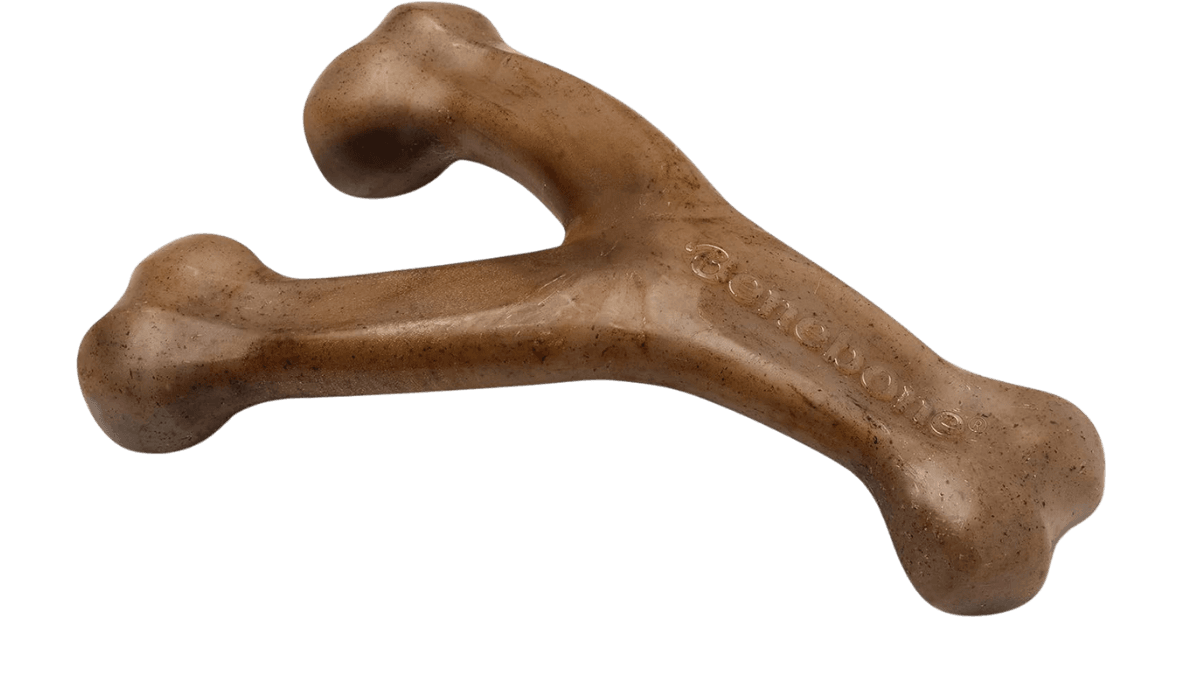

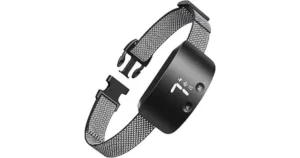
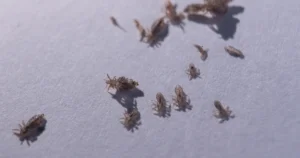
Pingback: What is the best natural allergy chews for dogs?
Pingback: The Best Cat Litter for Your Furry Friend